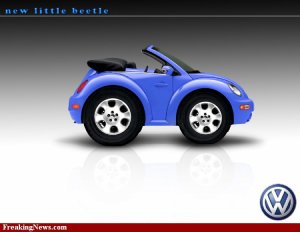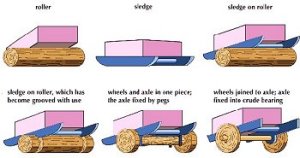102/100 BCE: Gaius Julius Caesar was born (by Caesarean section according to an unlikely legend) of Aurelia and Gaius Julius Caesar, a praetor. His family had noble, patrician roots, although they were neither rich nor influential in this period. His aunt Julia was the wife of Gaius Marius, leader of the Popular faction.
c. 85 BCE: His father died, and a few years later he was betrothed and possibly married to a wealthy young woman, Cossutia. This betrothal/marriage was soon broken off, and at age 18 he married Cornelia, the daughter of a prominent member of the Popular faction; she later bore him his only legitimate child, a daughter, Julia. When the Optimate dictator, Sulla, was in power, he ordered Caesar to divorce her; when Caesar refused, Sulla proscribed him (listed him among those to be executed), and Caesar went into hiding. Caesar’s influential friends and relatives eventually got him a pardon.
c. 79 BCE: Caesar, on the staff of a military legate, was awarded the civic crown (oak leaves) for saving the life of a citizen in battle. His general sent him on an embassy to Nicomedes, the king of Bithynia, to obtain a fleet of ships; Caesar was successful, but subsequently he became the butt of gossip that he had persuaded the king (a homosexual) only by agreeing to sleep with him. When Sulla died in 78, Caesar returned to Rome and began a career as a orator/lawyer (throughout his life he was known as an eloquent speaker) and a life as an elegant man-about-town.
75 BCE: While sailing to Greece for further study, Caesar was kidnapped by Cilician pirates and held for ransom. When informed that they intended to ask for 20 talents, he is supposed to have insisted that he was worth at least 50. He maintained a friendly, joking relationship with the pirates while the money was being raised, but warned them that he would track them down and have them crucified after he was released. He did just that, with the help of volunteers, as a warning to other pirates, but he first cut their throats to lessen their suffering because they had treated him well.
72 BCE: Caesar was elected military tribune. (Note that Pompey and Crassus were the consuls for 70 BCE.)
69 BCE: He spoke at the funerals of both his aunt, Julia, and his wife, Cornelia. On both occasions, he emphasized his connections with Marius and the ancient nobility of his family, descended from the first kings on his mother’s side and from the gods on his father’s (revealing a notable talent for self-dramatization and a conception that there was something exceptional about him).
68/67 BCE: Caesar was elected quaestor and obtained a seat in the Senate; he married Pompeia, a granddaughter of Sulla. Caesar supported Gnaeus Pompey and helped him get an extraordinary generalship against the Mediterranean pirates, later extended to command of the war against King Mithridates in Asia Minor.

65 BCE: He was elected curule aedile and spent lavishly on games to win popular favor; large loans from Crassus made these expenditures possible. There were rumors that Caesar was having an affair with Gnaeus Pompey’s wife, Mucia, as well as with the wives of other prominent men.
63 BCE: Caesar spent heavily in a successful effort to get elected pontifex maximus (chief priest); in 62 he was elected praetor. He divorced Pompeia because of her involvement in a scandal with another man, although the man had been acquitted in the law courts; Caesar is reported to have said, “The wife of Caesar must be above suspicion,” suggesting that he was so exceptional that anyone associated with him had to be free of any hint of scandal. In 61 he was sent to the province of Further Spain as propraetor.
60 BCE: He returned from Spain and joined with Pompey and Crassus in a loose coalition called by modern historians “The First Triumvirate” and by his enemies at the time “the three-headed monster.” In 62, Pompey had returned victorious from Asia, but had been unable to get the Senate to ratify his arrangements and to grant land to his veteran soldiers because he had disbanded his army on his return and Crassus was blocking his efforts. Caesar persuaded the two men to work together and promised to support their interests if they helped him get elected to the consulship.
59 BCE: Caesar was elected consul against heavy Optimate opposition led by Marcus Porcius Cato, a shrewd and extremely conservative politician. Caesar married his only daughter, Julia, to Pompey to consolidate their alliance; he himself married Calpurnia, the daughter of a leading member of the Popular faction. Caesar pushed Pompey’s measures through, helped Crassus’ proposals, and got for himself a five-year term as proconsul of Gaul after his consulship was over. However, he used some strong-arm methods in the Assembly and completely cowed his Optimate colleague in the consulship, Bibulus, so that jokers referred to the year as “the consulship of Julius and Caesar” (instead of “the consulship of Caesar and Bibulus”). Caesar was safe from prosecution for such actions as long as he held office, but once he became a private citizen again he could be prosecuted by his enemies in the Senate.
58 BCE: Caesar left Rome for Gaul; he would not return for 9 years, in the course of which he would conquer most of what is now central Europe, opening up these lands to Mediterranean civilization—a decisive act in world history. However, much of the conquest was an act of aggression prompted by personal ambition (not unlike the conquests of Alexander the Great). Fighting in the summers, he would return to Cisalpine Gaul (northern Italy) in the winters and manipulate Roman politics through his supporters (see this map of Caesar’s Gallic campaigns).
56 BCE: Caesar, Pompey, and Crassus met in Caesar’s province to renew their coalition, since Pompey had been increasingly moving toward the Optimate faction. Pompey and Crassus were to be consuls again, and Caesar’s command in Gaul was extended until 49 BCE.

54 BCE: Caesar led a three-month expedition to Britain (the was the first Roman crossing of the English Channel), but he did not establish a permanent base there. Meanwhile, Caesar’s coalition with Pompey was increasingly strained, especially after Julia died in childbirth in 54. In the following year, Crassus received command of the armies of the East but was defeated and killed by the Parthians.
52 BCE: Rioting in Rome led to Pompey’s extra-legal election as “consul without a colleague.” Without Julia and Crassus, there was little to bond Caesar and Pompey together, and Pompey moved to the Optimate faction, since he had always been eager for the favor of the aristocrats.
51 BCE: The conquest of Gaul effectively completed, Caesar set up an efficient provincial administration to govern the vast territories; he published his history The Gallic Wars. The Optimates in Rome attempted to cut short Caesar’s term as governor of Gaul and made it clear that he would be immediately prosecuted if he returned to Rome as a private citizen (Caesar wanted to run for the consulship in absentia so that he could not be prosecuted). Pompey and Caesar were maneuvered into a public split; neither could yield to the other without a loss of honor, dignity, and power.
49 BCE: Caesar tried to maintain his position legally, but when he was pushed to the limit he led his armies across the Rubicon River (the border of his province), which was automatic civil war. Pompey’s legions were in Spain, so he and the Senate retreated to Brundisium and from there sailed to the East. Caesar quickly advanced to Rome, set up a rump Senate and had himself declared dictator. Throughout his campaign, Caesar practiced—and widely publicized—his policy of clemency (he would put no one to death and confiscate no property). In a bold, unexpected move, Caesar led his legions to Spain, to prevent Pompey’s forces from joining him in the East; he allegedly declared, “I am off to meet an army without a leader; when I return, I shall meet a leader without an army.” After a remarkably short campaign, he returned to Rome and was elected consul, thus (relatively) legalizing his position.
48 BCE: Pompey and the Optimate faction had established a strong position in Greece by this time, and Caesar, in Brundisium, did not have sufficient ships to transport all his legions. He crossed with only about 20,000 men, leaving his chief legate, Mark Antony, in Brundisium to try to bring across the rest of the soldiers. After some rather desperate situations for Caesar, the rest of his forces finally landed, though they were greatly outnumbered by Pompey’s men. In the final battle, on the plains of Pharsalus, it is estimated that Pompey had 46,000 men to Caesar’s 21,000. By brilliant generalship, Caesar was victorious, though the toll was great on both sides; Caesar pardoned all Roman citizens who were captured, including Brutus, but Pompey escaped, fleeing to Egypt.
October 2, 48 BCE: Caesar, with no more than 4,000 legionaries, landed in Alexandria; he was presented, to his professed horror, with the head of Pompey, who had been betrayed by the Egyptians. Caesar demanded that the Egyptians pay him the 40 million sesterces he was owed because of his military support some years earlier for the previous ruler, Ptolemy XII (“The Flute Player”), who had put down a revolt against his rule with Caesar’s help. After Ptolemy XII’s death, the throne had passed to his oldest children, Cleopatra VII and Ptolemy XIII, as joint heirs. When Caesar landed, the eunuch Pothinus and the Egyptian general Achillas, acting on behalf of Ptolemy XIII (at this time about 12 years old), had recently driven Cleopatra (at this time about 20-21 years old) out of Alexandria. Cleopatra had herself smuggled into the palace in Alexandria wrapped in a rug (purportedly a gift for Caesar) and enlisted his help in her struggle to control the Egyptian throne. Like all the Ptolemies, Cleopatra was of Macedonian Greek descent; she was highly intelligent and well-educated. Caesar saw her as a useful ally as well as a captivating female, and he supported her right to the throne. Through the treachery of Pothinus and the hostility of the Egyptian people to the Romans, Achillas and an army of 20,000 besieged the palace. Caesar managed to hold the palace itself and the harbor; he had Pothinus executed as a traitor but allowed the young Ptolemy to join the army of Achillas. When he ordered the Egyptian fleet burnt, the great Library of Alexandria was accidently consumed in the flames.
 |
| drawing of Caesar with general’s cloak; see also this statue |
February, 47 BCE: After some months under siege, Caesar tried unsuccessfully to capture Pharos, a great lighthouse on an island in the harbor; at one point when cut off from his men he had to jump in the water and swim to safety. Plutarch says that he swam with one hand, using the other to hold some important papers above the water; Suetonius adds that he also towed his purple general’s cloak by holding it in his teeth so that it would not be captured by the Egyptians.
March, 47 BCE: Caesar had sent for reinforcements, two Roman legions and the army of an ally, King Mithridates; when they arrived outside Alexandria he marched out to join them and on March 26 defeated the Egyptian army (Ptolemy XIII died in this battle). Although he had been trapped in the palace for nearly six months and had been unable to exert a major influence on the conduct of the civil war, which was going rather badly without him, Caesar nevertheless remained in Egypt until June, even cruising on the Nile with Cleopatra to the southern boundary of her kingdom.
June 23, 47 BCE: Caesar left Alexandria, having established Cleopatra as a client ruler in alliance with Rome; he left three legions under the command of Rufio, as legate, in support of her rule. Either immediately before or soon after he left Egypt, Cleopatra bore a son, whom she named Caesarion, claiming that he was the son of Caesar.
August, 47 BCE: After leaving Alexandria, Caesar swept through Asia Minor to settle the disturbances there. On August 1, he met and immediately overcame Pharnaces, a rebellious king; he later publicized the rapidity of this victory with the slogan veni, vidi, vici (“I came, I saw, I overcame”).
October, 47 BCE: Caesar arrived back in Rome and settled the problems caused by the mismanagement of Antony. When he attempted to sail for Africa to face the Optimates (who had regrouped under Cato and allied with King Juba of Numidia), his legions mutinied and refused to sail. In a brilliant speech, Caesar brought them around totally, and after some difficult battles decisively defeated the Optimates at Thapsus, after which Cato committed suicide rather than be pardoned by Caesar.
 |
| coin issued by Caesar depicting military trophy |
July 25, 46 BCE: The victorious and now unchallenged Caesar arrived back in Rome and celebrated four splendid triumphs (over the Gauls, Egyptians, Pharnaces, and Juba); he sent for Cleopatra and the year-old Caesarion and established them in a luxurious villa across the Tiber from Rome. In a letter at this time he listed his political aims as “tranquility for Italy, peace for the provinces, and security for the Empire.” His program for accomplishing these goals—both what he actually achieved and what he planned but did not have time to complete—was sound and farsighted (e.g., resolution of the worst of the debt crisis, resettlement of veterans abroad without dispossessing others, reform of the Roman calendar, regulation of the grain dole, strengthening of the middle class, enlargement of the Senate to 900), but his methods alienated many of the nobles. Holding the position of dictator, Caesar governed autocratically, more in the manner of a general than a politician. Although he nominally used the political structure, he often simply announced his decisions to the Senate and had them entered on the record as senatorial decrees without debate or vote.
April, 45 BCE: The two sons of Pompey, Gnaeus and Sextus, led a revolt in Spain; since Caesar’s legates were unable to quell the revolt, Caesar had to go himself, winning a decisive but difficult victory at Munda. Gnaeus Pompey was killed in the battle, but Sextus escaped to become, later, the leader of the Mediterranean pirates.
October, 45 BCE: Caesar, back in Rome, celebrated a triumph over Gnaeus Pompey, arousing discontent because triumphs were reserved for foreign enemies. By this time Caesar was virtually appointing all major magistrates; for example, when the consul for 45 died on the morning of his last day of office, Caesar appointed a new consul to serve out the term—from 1:00 p.m. to sundown! Caesar was also borrowing some of the customs of the ruler cults of the eastern Hellenistic monarchies; for example, he issued coins with his likeness (note how the portrait on this coin, celebrating his fourth dictatorship, emphasizes his age) and allowed his statues, especially in the provinces, to be adorned like the statues of the gods. Furthermore, the Senate was constantly voting him new honors—the right to wear the laurel wreath and purple and gold toga and sit in a gilded chair at all public functions, inscriptions such as “to the unconquerable god,” etc. When two tribunes, Gaius Marullus and Lucius Flavius, opposed these measures, Caesar had them removed from office and from the Senate.
February, 44 BCE: Caesar was named dictator perpetuus. On February 15, at the feast of Lupercalia, Caesar wore his purple garb for the first time in public. At the public festival, Antony offered him a diadem (symbol of the Hellenistic monarchs), but Caesar refused it, saying Jupiter alone is king of the Romans (possibly because he saw the people did not want him to accept the diadem, or possibly because he wanted to end once and for all the speculation that he was trying to become a king). Caesar was preparing to lead a military campaign against the Parthians, who had treacherously killed Crassus and taken the legionary eagles; he was due to leave on March 18. Although Caesar was apparently warned of some personal danger, he nevertheless refused a bodyguard.
March 15, 44 BCE: Caesar attended the last meeting of the Senate before his departure, held at its temporary quarters in the portico of the theater built by Pompey the Great (the Curia, located in the Forum and the regular meeting house of the Senate, had been badly burned and was being rebuilt). The sixty conspirators, led by Marcus Junius Brutus, Gaius Cassius Longinus, Decimus Brutus Albinus, and Gaius Trebonius, came to the meeting with daggers concealed in their togas and struck Caesar at least 23 times as he stood at the base of Pompey’s statue. Legend has it that Caesar said in Greek to Brutus, “You, too, my child?” After his death, all the senators fled, and three slaves carried his body home to Calpurnia several hours later. For several days there was a political vacuum, for the conspirators apparently had no long-range plan and, in a major blunder, did not immediately kill Mark Antony (apparently by the decision of Brutus). The conspirators had only a band of gladiators to back them up, while Antony had a whole legion, the keys to Caesar’s money boxes, and Caesar’s will. Click here for some assessments of Caesar by modern historians.
 |
| first century BCE portrait bust with features resembling Caesar’s, found in Ancient Thera |
Sources
Barbara F. McManus, The College of New Rochelle
bmcmanus@cnr.edu
revised March, 2011














